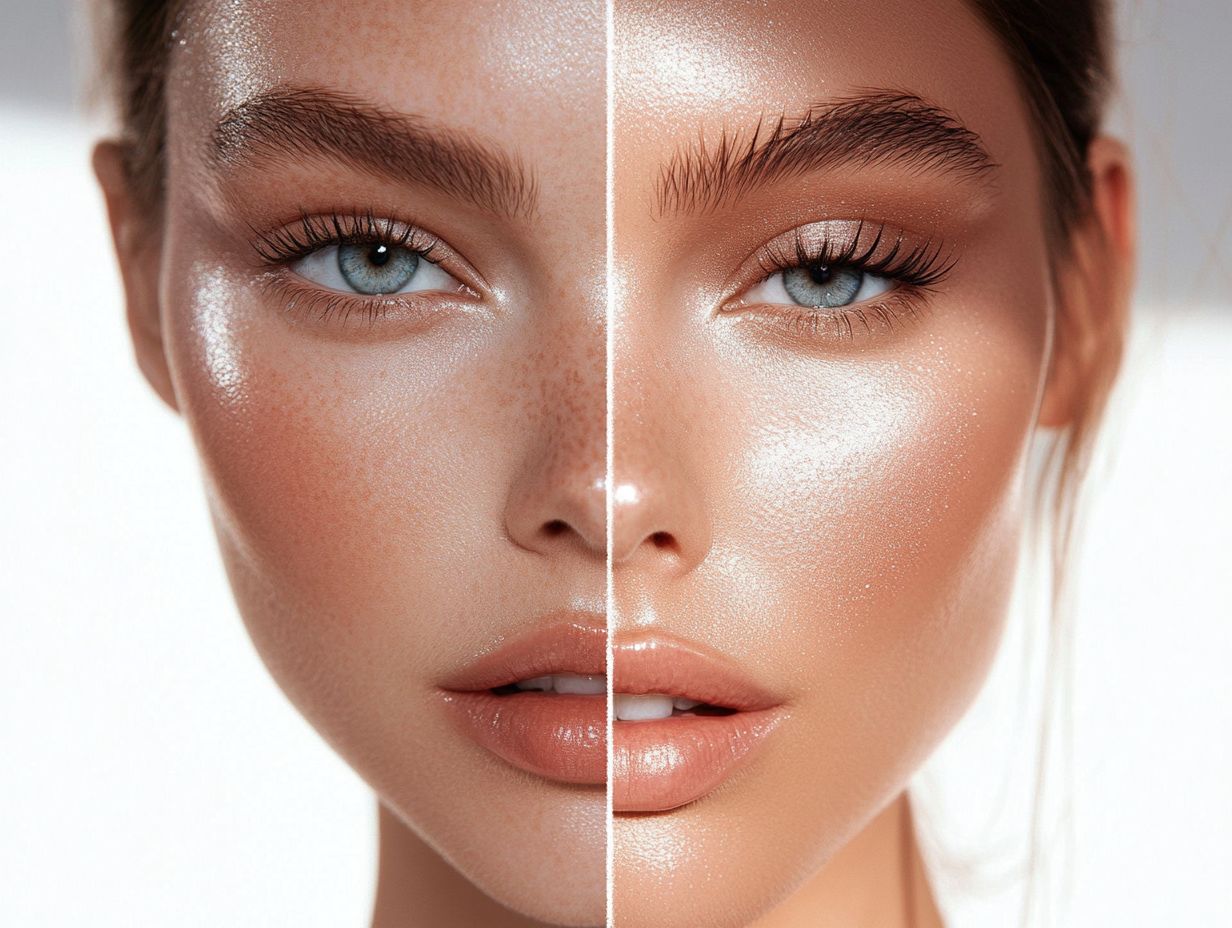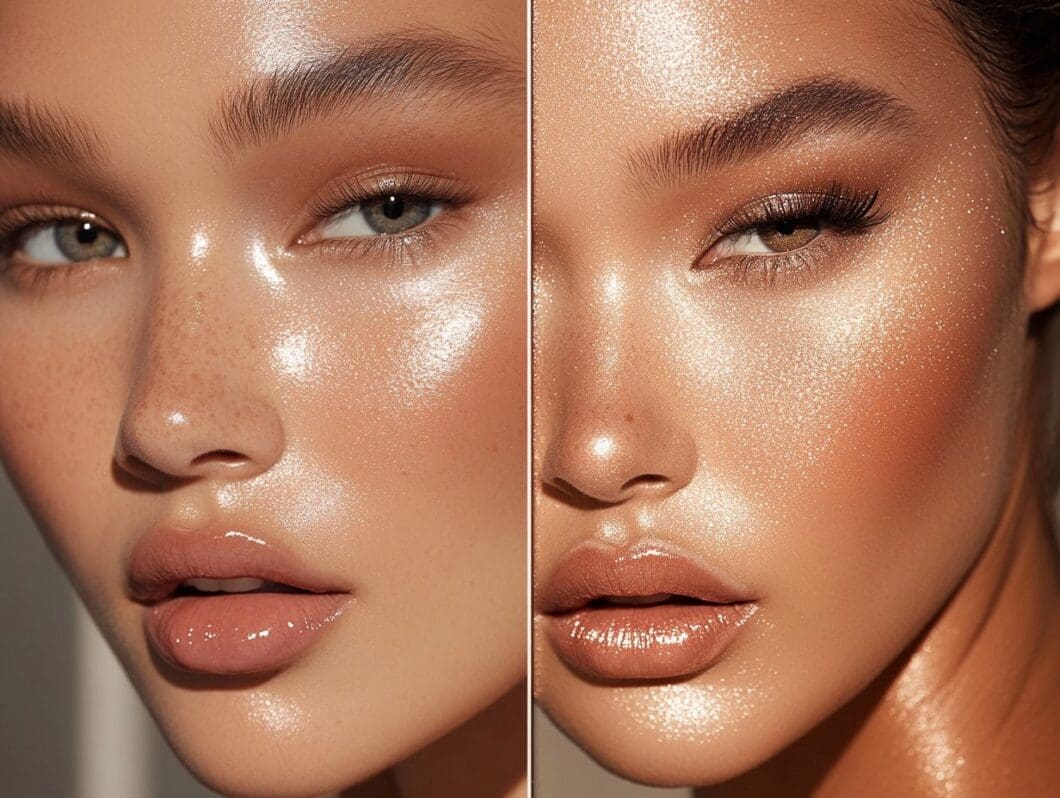Highlighting and strobing are two popular makeup techniques that can elevate your beauty game, but they often get confused.
Whether you’re aiming for a subtle glow or a bold, luminous finish, understanding the nuances between the two is essential.
This article explores the differences, benefits, and application methods for highlighting and strobing. Additionally, it shares tips on choosing the right products and avoiding common mistakes, ensuring you achieve that radiant look effortlessly.
Dive in and discover how to enhance your features and create a stunning glow!
Key Takeaways:

Understanding Highlighting and Strobing
Highlighting and strobing are fundamental techniques in the makeup industry that enhance natural features and create a radiant, luminous appearance. These methods concentrate on accentuating specific areas such as the cheekbones, brow bone, bridge of the nose, and Cupid’s bow, ensuring a beautiful glow of the skin under various lighting conditions.
Utilizing products like Fenty’s Trophy Wife allows individuals to apply these techniques effectively, adapting them to diverse skin tones for a flawless finish. A comprehensive understanding of the nuances associated with highlighting and strobing is essential for achieving well-defined features that elevate an overall makeup routine.
What are Highlighting and Strobing?
Highlighting and strobing are advanced techniques employed to enhance the natural luminosity of the skin, resulting in a radiant and dewy finish that complements all skin tones.
These methods involve the strategic application of products to accentuate the prominent features of the face, including the cheekbones, brow bones, and the bridge of the nose.
Highlighters, available in various formulations such as cream, liquid, and powder, play a crucial role in achieving this desired glow. Cream products typically provide a more subtle, natural appearance and blend seamlessly into the skin. In contrast, powder highlighters offer a more pronounced sheen and often contain light-reflecting particles that capture and amplify light.
Additionally, illuminating creams can serve as a foundational layer, enriching the skin’s surface prior to the application of other makeup products, thereby enhancing the overall effect and depth of luminosity.
The Difference Between Highlighting and Strobing

Highlighting and strobing, although they may appear similar, serve distinct purposes in makeup artistry, each employing unique techniques and effects designed to enhance natural beauty.
Highlighting generally involves the application of products to specific areas to draw attention and create depth. Conversely, strobing emphasizes the addition of a continuous, radiant glow to the skin, resulting in a fresher, more dewy finish.
Recognizing these differences enables individuals to tailor their makeup routines for special occasions or everyday wear, rendering these techniques invaluable assets in any makeup artist’s repertoire.
Techniques and Effects
The techniques employed in highlighting and strobing can significantly influence the overall impact of makeup, allowing for well-defined features and an enviable dewy finish that enhances one’s appearance.
While these methods share a similar foundation, they utilize distinct products and tools to achieve varying levels of luminosity. Highlighting typically involves the application of cream or powder highlighters to the elevated areas of the face, such as the cheekbones, brow bones, and the bridge of the nose, resulting in a radiant glow. Conversely, strobing emphasizes an intense shine by using products like liquid illuminators, which enhance specific regions for a more dramatic effect.
Additionally, selecting different shades—such as golden tones for warm skin tones or pearlescent options for cooler complexions—can transform an everyday look into something extraordinary. For example, applying a soft champagne highlighter on lighter skin can create a natural brightness, while deeper bronze shades can beautifully accentuate the warmth in darker skin tones, showcasing a spectrum of stunning possibilities.
Benefits of Highlighting and Strobing
Highlighting and strobing present numerous advantages that can significantly enhance one’s makeup routine. These techniques not only accentuate facial features but also create an ethereal glow that captures attention.
By illuminating the skin, they draw focus to key areas such as the cheekbones and brow bone, contributing to a more sculpted appearance. Furthermore, these methods promote a fresh and youthful look, while also allowing individuals to express their creativity and personal style, whether for special occasions or daily wear.
Incorporating these techniques into one’s beauty regimen can elevate overall appearance and enhance self-confidence.
Enhancing Features and Creating a Glowing Look

Enhancing facial features through strobing and highlighting techniques can produce a striking, radiant appearance that conveys confidence and vitality.
By utilizing various highlighting methods, individuals can subtly emphasize their cheekbones and brow bone, effectively drawing attention to their natural beauty. These techniques typically involve the strategic layering of light-reflecting products, creating an impression of depth and dimension.
The synergy between skincare and makeup is essential in achieving this luminous effect; a well-hydrated complexion provides an ideal foundation.
Emphasizing the significance of thorough cleansing and moisturizing ensures that the skin appears fresh, allowing highlighters to illuminate the face more effectively. This attention to skincare ultimately enhances overall appearance and radiance.
How to Achieve the Perfect Highlight and Strobe
Achieving optimal highlight and strobe effects necessitates a thoughtful combination of techniques, product selections, and application methods that are specifically tailored to individual skin tones and desired finishes. It is imperative to begin by selecting the appropriate highlighter, whether it be cream products, baked highlighting powders, or liquid formulas, ensuring it complements the skin tone—be it warm, cool, or neutral.
Once the products have been chosen, mastering the application techniques is crucial for creating a luminous glow that enhances one’s natural features.
Tips and Tricks for Application
Application techniques are pivotal in determining the effectiveness of highlighting and strobing, and familiarizing oneself with certain tips and tricks can facilitate a flawless finish.
Utilizing appropriate tools, such as soft brushes or damp beauty blenders, can significantly improve the way light interacts with the skin. Understanding the distinction between strobing and traditional highlighting is essential; while strobing produces a dewy, illuminated effect on the high points of the face, traditional highlighting serves to define facial features with greater structure.
It is also imperative to avoid the common error of applying excessive product, which may lead to an overly shiny appearance. Instead, it is advisable to start with a small quantity and gradually build up, ensuring a natural glow that enhances the overall makeup look.
Choosing the Right Products for Highlighting and Strobing

Selecting the appropriate products for highlighting and strobing is essential for creating a flawless makeup look that complements one’s unique style and skin tone.
Given the numerous options available, including highlighter shades from reputable brands such as L’Oréal Paris and Juvia’s Place, it is imperative to consider factors such as formulation, finish, and skin type.
Whether one favors the subtle radiance of a baked highlighting powder or the pronounced shimmer of a jelly highlighter, understanding how to choose the right product can greatly impact one’s overall appearance.
Types of Products and Their Uses
Highlighting and strobing products are available in various formulations, each providing distinct benefits and application methods suited to diverse makeup aesthetics.
Whether in cream, powder, or liquid form, each texture serves a specific purpose in achieving the desired luminosity. Cream highlighters deliver a dewy finish, making them ideal for individuals seeking to create a fresh and youthful appearance. In contrast, powder highlighters provide a more intense sparkle, which is particularly suitable for evening events. Liquid highlighters offer versatility; they can be blended with foundation for an all-over glow or applied directly to the high points of the face for a more concentrated effect.
The selection between a warm or cool finish can significantly impact the overall ambiance of a makeup look, thereby emphasizing the importance of choosing the appropriate product based on one’s skin tone and desired aesthetic.
Common Mistakes to Avoid
Avoiding common mistakes in highlighting and strobing can significantly impact the outcome, determining whether one achieves a radiant glow or an overdone, unnatural appearance that detracts from the overall makeup routine.
Many individuals inadvertently apply excessive product or select shades that do not complement their skin tone, resulting in harsh lines and an unflattering finish. By remaining mindful of these potential pitfalls, one can effectively achieve the desired luminosity and well-defined features that these techniques are intended to enhance.
Avoiding Overdone or Unnatural Looks
To avoid an overly dramatic or unnatural appearance while utilizing highlighting and strobing techniques, it is essential to understand one’s skin tone and select products that enhance rather than detract from natural beauty.
Makeup artists frequently underscore the significance of choosing formulas specifically developed to complement various skin types. Cream and liquid highlighters offer a more seamless blend, achieving a desirable glow without harsh lines.
Furthermore, it is crucial to apply these products with a light touch, gradually building intensity to ensure a soft, luminous effect. Proper placement is paramount; strategically applying highlights to the high points of the face—such as the cheekbones, brow bones, and bridge of the nose—can create dimension and lift. Strobing should serve to enhance the skin’s texture rather than conceal it.
By implementing these techniques, individuals can attain a beautifully radiant complexion.


